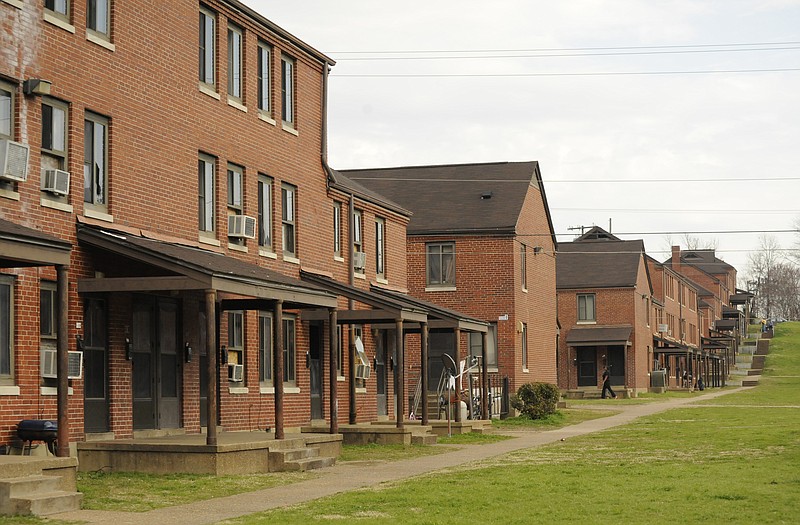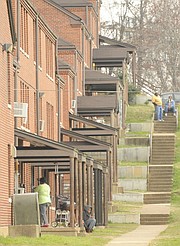Roaches crawl on Lisa Bailey's hallway walls. Water damage shows on her ceiling and mold grows in the corner of her disabled mother's bedroom.
"Can't you see where the house flooded?" said Bailey, pointing to dingy water stains on the wall and ceiling of her College Hill Courts apartment. "They've been coming to fix it for five years and ain't did nothing yet," said Bailey, a 15-year resident.
Other residents have complained about bad wiring, peeling paint and having no dryer hook-ups.
The Chattanooga Housing Authority says it doesn't have money to repair the 76-year-old complex, the oldest and largest public housing site in the city. But the site is home to nearly 500 low-income families and housing officials know they have to do something.
CHA Executive Director Betsy McCright is applying in November to demolish 170 units at College Hill Courts and hopes to replace the units by partnering with private developers to put affordable housing in various sites around Chattanooga.
The U.S. Department of Housing and Urban Development (HUD) estimates aging public housing sites across the country need $26 billion worth of repairs. With no money for the work, CHA is taking a different path toward housing for low-income people.
The relatively new HUD program called Rental Assistance Demonstration, or RAD, is revolutionary because it essentially eliminates public housing and replaces it with privately built affordable housing, said housing officials.
Last week, CHA board members approved a resolution allowing McCright to apply for a RAD designation for College Hill Courts. If it goes through, CHA would use tax credits to help private investors build new, project-based low-income housing. The housing authority would own the land, but the builders would own the housing for about 15 years, when CHA could buy it back, said CHA's vice president of development, Naveed Minhas.
But not everyone is convinced RAD is a solution.
The national controversy concerning RAD is that it uses private investors to help fund public housing repairs. Once private investors get involved, the housing is no longer public housing, opponents say.
U.S. Rep. Maxine Waters, D-Calif., wrote in a news release in October 2015 that she is "concerned that the [RAD] demonstration's primary reliance on private capital essentially depletes our nation's stock of public housing over time by allowing the privatization of an asset that has always been publicly owned."
Waters said she also was concerned that tenants' rights may not be properly protected in the RAD conversion process, according to her letter to the Comptroller General asking the RAD program be reviewed.
As of October 2015, the RAD program had allowed more than 185,000 public housing units across the country to be converted to private ownership, Waters said in her letter. She said some estimates show the country loses 10,000 public housing units a year to demolition and disposition, yet there is a nationwide shortage of affordable housing.
***
The proposed new housing to replace College Hill Courts will not be confined to that Westside site. The housing authority seeks to purchase 5-acre parcels throughout the city and put 50 to 75 housing units on each parcel. The hope is to replace the 179 demolished units first, and eventually all 497 units on the site.
The goals are to provide 1-for-1 housing replacement for the demolished College Hill Courts and to deconcentrate poverty, McCright said.
And as in public housing, low-income residents who live in the RAD housing will never be charged more than one-third of their income for rent.
"We'll be using tax credits and project-based vouchers to run the properties so they'll be run more like private rental market properties, but they will still be affordable for residents," said McCright.
The RAD designation gives the housing authority the ability to get 9 percent tax credits, which is really valuable for redevelopment, McCright said. The housing authority will work with private investors and developers.
Minhas said a 9 percent tax credit could mean up to $11 million or $12 million toward the development of new housing.
McCright said the housing authority would move College Hill residents into other public housing sites or into rental- voucher housing before it demolishes the units. Some could move into new units anticipated at the Cromwell Hills site. The proposed $38 million Cromwell renovation will include more than 50 new housing units and a renovation of the 200 units already on the site.
Housing officials said it would be at least two years before residents see anything happening.
It could take a year to get HUD approval for a RAD, said McCright. If that happens in 2017, it would be 2018 before CHA applied for tax credits.
"We're looking years down the road," McCright said. "But at least we're getting ourselves poised to be in line for it."
***
College Hill Courts, built in the 1940s, exemplifies old, rundown public housing stock across the country. Repairing the homes is estimated to cost nearly $50 million. The similar East Lake Courts needs another $38 million in repairs. CHA got less than $4 million in capital funds this year for repairs.
Minhas said the cost of new construction would be significantly lower than trying to fix up the worn-out, outdated apartments.
"RAD is the way HUD is moving at this point across the nation," said Jim Sattler, CHA board vice chairman. "It should give us some new affordable units that displace some of the older units that are going to be coming out of service."
Congress developed RAD in 2012 to address the capital needs of public housing agencies across the country, totaling $26 billion, according to HUD.
College Hill Courts is home to nearly 500 low- income families. It is one of four communities named in the Chattanooga Gang Assessment where much of the gang violence throughout the city is confined. The neighborhood holds a poverty rate of 61.6 percent - more than half the households receive food stamps and nobody owns a home, according to the Chattanooga Gang Assessment published in 2012.
Bailey's 20-year-old son, Elton Hall, was fatally shot at the housing site in 2005. More recent homicide victims include 20-year-old Keiara Patton, shot in 2014, and 20-year-old Talitha Bowman, shot in 2015. And Aisha Bearden, 23, was found dead in her College Hill Courts apartment on her July 4 birthday this year.
Bailey suggests CHA will "tear it down." And if all goes as planned, she may get her wish.
Contact staff writer Yolanda Putman at yputman@timesfreepress.com or 423-757-6431.

